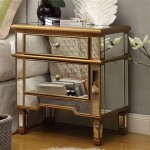Hanging a Large Frameless Mirror
Mounting a large frameless mirror presents a unique set of challenges. The absence of a frame removes the usual mounting points and requires specialized hardware and techniques to ensure the mirror is secured safely and aesthetically. This article provides a comprehensive guide to successfully hanging a large frameless mirror.
Planning and Preparation
Careful planning is crucial for a successful installation. Begin by accurately measuring the mirror's dimensions and weight. This information is essential for selecting the appropriate mounting hardware and determining the number of mounting points required. Consider the wall material – drywall, concrete, or tile – as this will influence the type of anchors and fasteners needed. Finally, choose a location that offers adequate support and complements the room's design.
Choosing the Right Mounting Hardware
Several mounting options are available for frameless mirrors, each with its advantages and disadvantages. Adhesive clips are a popular choice for lighter mirrors, offering a clean, minimalist look. However, these may not be suitable for very heavy or oversized mirrors. For heavier mirrors, J-bars or Z-clips provide a more secure mounting solution. J-bars offer support from the bottom and sides, while Z-clips grip the mirror from the top and bottom. Mirror mastic, a specialized adhesive, can be used in conjunction with other hardware or as a standalone mounting solution, especially for very heavy mirrors. Always prioritize hardware rated to support a weight significantly exceeding the mirror's actual weight for added safety.
Marking and Positioning
Accurate placement is critical for a visually appealing result. Use a level and pencil to mark the desired position of the mirror on the wall. Measure and mark the locations for the mounting hardware, ensuring they are evenly spaced and aligned. Double-check all measurements before proceeding to drilling or applying adhesive. Accuracy at this stage will prevent costly mistakes and ensure the mirror hangs straight and securely.
Installing the Mounting Hardware
The installation process varies depending on the chosen hardware and wall type. When using adhesive clips, ensure the wall surface is clean and dry. Follow the manufacturer's instructions for applying the adhesive and securing the clips to the wall and the mirror. For J-bars or Z-clips, pre-drill pilot holes in the wall at the marked locations, using the appropriate drill bit for the wall material. Insert the wall anchors and then screw the mounting hardware into place. Ensure the hardware is securely fastened to provide adequate support for the mirror.
Mounting the Mirror
With the mounting hardware securely in place, carefully lift the mirror and position it onto the mounting hardware. For adhesive clips, press the mirror firmly against the clips to ensure a strong bond. With J-bars, slide the mirror down into the J-shaped brackets. For Z-clips, engage the top clips first, then carefully lower the mirror onto the bottom clips. Ensure the mirror is level and flush against the wall. Have an assistant help with this step, especially for large or heavy mirrors, to prevent accidents and ensure proper alignment.
Safety Considerations
Safety should be paramount throughout the entire process. Wear appropriate safety glasses and gloves when handling the mirror and drilling into walls. Ensure the chosen mounting location is structurally sound and capable of supporting the weight of the mirror. Never hang a heavy mirror on drywall alone; always use appropriate wall anchors. If unsure about any aspect of the installation process, consult a qualified professional. Regularly inspect the mirror and mounting hardware to ensure they remain secure.
Cleaning and Maintenance
Once installed, clean the mirror using a suitable glass cleaner and a soft, lint-free cloth. Avoid abrasive cleaners or scrubbers that could scratch the mirror surface. Regularly dust the mirror to maintain its shine and clarity. Periodically check the mounting hardware for any signs of loosening or damage and tighten or replace as needed. This preventative maintenance will help ensure the long-term safety and aesthetic appeal of your frameless mirror.
Alternative Mounting Methods: Mirror Mastic
While J-bars, Z-clips, and adhesive clips are common choices, mirror mastic provides another secure method, particularly for large, heavy mirrors. Apply the mastic to the back of the mirror in vertical beads, following the manufacturer's instructions for spacing and quantity. Then, carefully position the mirror onto the wall, pressing firmly to ensure good adhesion. Temporary supports may be necessary while the mastic cures, which can take several days. This method offers a strong bond and eliminates visible hardware, resulting in a clean, modern look.

How To Hang A Frameless Mirror On The Wall With Pictures

How To Hang A Frameless Mirror June 2024 Your Guide Hanging

How To Hang A Frameless Mirror On Wall E Architect
How To Hang A Heavy Mirror At Home

How To Hang A Frameless Mirror On Wall E Architect

How To Hang A Frameless Mirror On The Wall With Pictures

Frameless Antique Mirror Round Hanging Wall Made With Custom Antiqued Perfect For Chic Interior Space

How To Hang A Heavy Mirror At Home

Frameless Antique Mirror Round Hanging Wall Made With Custom Antiqued Perfect For Chic Interior Space

How To Hang A Heavy Mirror C R F T








